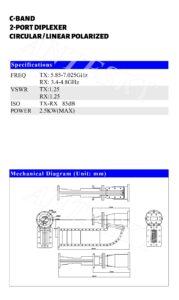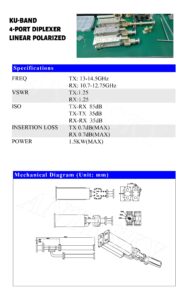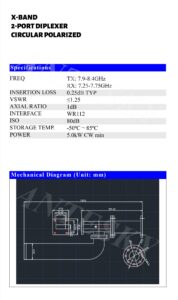
Orthomode transducers (OMT) are devices used in radio frequency (RF) systems, particularly in satellite communication antenna systems, to separate or combine signals of different polarizations.
The Ortho-Mode Transducer (OMT) is a crucial component in radio frequency systems, particularly in satellite communication antenna and radar systems. It plays a significant role in separating and combining signals of different polarizations. Antesky is engaged in supplying OMT/Feed system series for satellite antennas in China.
As we all know, engineers in the satellite communications industry often mention antennas and OMT in various frequency bands such as C-band OMT, L-band OMT, Ku-band OMT, and Ka-band OMT. Have you ever thought about why they are named like this? The C, Ku, and X bands refer to specific frequency ranges within the electromagnetic spectrum. Please refer to this article about we posted the origin of electromagnetic waves band naming previously. We believe you will learn further about band naming.
- Key Functions of an OMT:
Isolation: Ensures that signals of one polarization do not interfere with signals of the other polarization.
Combining: Allows the combination of signals with different polarizations for transmission or reception through a single feed system.
- Advantages of Using OMTs:
OMT can improve system performance by minimizing signal interference.
OMT is useful for dual-polarization antennas, enhancing communication and radar system capabilities.
OMT is essential in systems requiring simultaneous transmission and reception.
- Application of OMT
3.1 Satellite Communication Systems
3.1.1 C band OMT
Frequency Range: 4 to 8 (GHz)
Wavelength: 3.75 cm -7.5 cm
Applications:
- Telecommunications: C band is commonly used for long-distance radio telecommunications.
- Broadcasting: It has been historically used for satellite television broadcasting.
- Weather Radar: C band is also employed in weather radar systems.
Below is some different C band ranges around the world.
| C-band variations around the world | ||
| Band | Transmit frequency (GHz) |
Receive frequency (GHz) |
| Standard C band | 5.850–6.425 | 3.625–4.200 |
| Super extended C band | 6.425–6.725 | 3.400–3.625 |
| INSAT / ITU Appendix 30B | 6.725–7.025 | 4.500–4.800 |
| Russian C band | 5.975–6.475 | 3.650–4.150 |
| LMI C band | 5.7250–6.025 | 3.700–4.000 |
C band OMTs are employed in satellite communication systems operating in this frequency range. Antesky C band 2 port OMT.
3.1.2 Ku-Band OMT
Frequency Range: 12 to 18 GHz
Wavelength: 16.7 cm -25 cm
Applications:
- Direct-to-Home (DTH) Broadcasting: Ku band is extensively used for DTH satellite television broadcasting.
- VSAT (Very Small Aperture Terminal) Systems: Ku band is popular for VSAT systems, providing two-way communication for data, internet, and video services.
- Satellite News Gathering (SNG): Ku band is used for transmitting live news feeds via satellite.
- Military Communications: Ku band is also used in military applications for communication and radar.
Ku band is widely utilized for satellite communication, including satellite broadcasting, broadband internet access, and other telecommunications applications. Satellites in geostationary orbit often use Ku band for uplink and downlink communication.
Offers higher data rates and is widely used for satellite broadcasting and broadband services. Ku band OMTs are utilized in systems operating in this frequency range. Antesky Ku band 4 port OMT detailed introduction as below.
3.1.3 X-Band OMT
Frequency Range: 8 to 12 GHz
Applications:
- Military Communications: X band is widely used in military applications for secure communications and radar systems.
- Satellite Communications: It is also used for satellite communications, especially for smaller and more precise satellite dishes.
- Remote Sensing: X band is used in remote sensing applications, such as earth observation and environmental monitoring.
X band OMTs find applications in military and communication satellite systems. Here please find below detailed data sheet of Antesky X band OMT.
3.2 Polarization Separation/Combination:
OMTs are crucial in systems where signals of different polarizations need to be separated or combined. They allow for the simultaneous transmission and reception of linear and circular polarizations.
3.3 Dual-Polarization Systems:
In satellite communication, it’s common to use dual-polarization systems to maximize the utilization of available bandwidth. OMTs play a key role in enabling dual-polarization communication.
3.4 Feed Systems for Antennas:
OMTs are often used as feed systems for antennas in satellite ground stations. They ensure that signals of different polarizations are properly directed to the corresponding feed horns or elements.
3.5 Interference Mitigation:
By separating signals of different polarizations, OMTs help in mitigating interference between signals. This is especially important in crowded satellite communication scenarios.
3.6 Frequency Band Adaptation:
OMTs designed for specific frequency bands like C, Ku, or X bands help adapt the satellite communication system to the desired frequency range.
3.7 Earth Observation Satellites:
OMTs are used in Earth observation satellites operating in C, Ku, or X bands. These satellites capture high-resolution images and data for various applications, including environmental monitoring and resource management.
3.8 Military and Defense Applications:
In military communication and radar systems, X band OMTs are often used for their ability to provide high data rates and precise targeting capabilities.
In summary, the C/ku/x band OMT is a critical component in satellite antennas systems operating in the C, Ku, and X bands. It facilitates the efficient separation and combination of signals with different polarizations, contributing to the overall performance and functionality of communication and radar systems in these frequency ranges. If you are interested in anything about satellite antenna communication, welcome to talk with us via sales@antesky.com or can send us WhatsApp message here directly.









